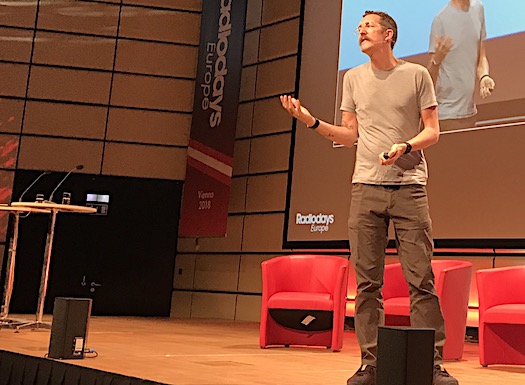Futurist Ben Hammersley predicts that linear radio will no longer be the dominant platform in the future.
“My three year old daughter is thoroughly confused about linear broadcast radio. She gets hysterical because she cannot skip tracks she doesn’t like. She starts shouting at the radio saying, ‘Alexa skip track, but it won’t skip for her.
“The debates about platforms such as broadcast audio, IP, DAB are utterly irrelevant to the next generation growing up. Kids don’t understand linear broadcasting, it’s too weird,” he said.
Exponential changes in computational capabilities are “giving us superpowers to do all sorts of cool stuff.” Hammersley urged the radio industry to think differently to be able to respond to audience needs of the future.
Hammersley mentioned several new apps as examples of innovations: One is a new app that allows multiple audio calls to be recorded for podcasts all at studio quality.
New technology is also being used by a BBC Radio 4 producer (Hammersley’s wife) to make an award winning radio show from her cupboard under the stairs in Los Angeles.
Another example he talked about was a new podcast called Hatches Matches and Dispatches, which is produced by a team of six people who have never met, using apps and remote location equipment.
“Modern technology is enabling high quality programming from cupboards under the stairs located anywhere… We are making programs in different ways and people are listening in different ways.”
Listening is having a resurgence thanks to new technology according to Hamersley. “Earbud headphones are some of the best selling products in the world… Audio can create a mental third space, a place of refuge where you go when you are commuting from one place to the other.”
So what conclusions can we come to when looking at all the technological changes happening around us?
Hammersley says, “in terms of the younger demographics and the future, IP data has won.” Nobody cares about the technology when they have a ubiquitous device that can allow you to listen to audio from any transmission source.
“Digital developments have developed and changed our expectations about how the world works… one of these is that we will listen to audio, but it may not be linear radio.”
“Alexa, play the next one,” is a scary phrase.
Hamersley told the story of how his daughter has seen her parents talk to their devices. She has “weaponised audio control and artificial intelligence” to play her audio as loud as she wants, even when her parents disapprove.
Niche-ification means that people are developing new loyalties because there are so many niche content offerings that are relevant to them. For instance, his daughter listens to children’s podcasts. “We are starting to realise that niche content, plus low overheads, is way more valuable than mass market content in a business sense.”
Targeted advertising platforms are another priority area. “Young audio makers are not going to big broadcasters to get jobs, they are creating their own jobs by making niche content and using targeted ad platforms to sell it and make a good living for themselves.”
There are still problems for the audio industry to solve, including discovery of content and compounding excellence (stealing good ideas, making everybody, including your competitors, a lot better).
“We are in a golden age of audio programming because we can listen to the best from around the world and learn from one another. It is great for program makers and for the listener. But now listeners can also know what is poor to average content and so poor quality broadcasters will not be saved by geography any more.”
He thinks that traditional radio delivery is dead, but that audio is not dead, in fact it is thriving. It will be important for traditional broadcasters to get their heads around the way new platforms are delivering their audio and how listeners want to listen to it.
“Don’t make the Kodak mistake, they did not see the potential of digital cameras. They had seen the technology that would kill them but they ignored it, and it killed them. In the first year of the iPhone, more pictures were taken than had been taken in all of the history of the camera up to that time.”
‘Constant legacy-free reinvention’ is the way to think so that you can imagine what need to be done to future proof the radio industry. He suggested this thinking model:
“Choose a day. During that day pay attention to everything you are doing and ask why am I doing this, what problem am I solving? When you have that information, ask yourself can I solve this in a better way using modern technology?”

